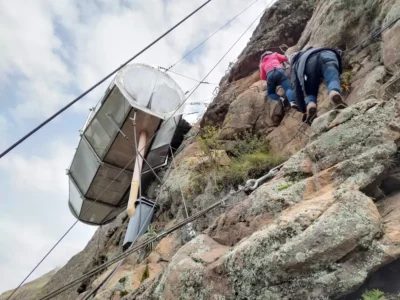We tend to think of phobias as being brought about by real-life situations. Think, for example, of an arachnophobe’s reaction when seeing a spider, or how someone with claustrophobia would feel when stuck in a small space. However, simply seeing a depiction of one’s fears can give rise to the same reactions. This is even more likely when the content is immersive—such as when gaming. You might therefore wonder if it’s possible for video games to trigger symptoms of acrophobia.
In this article, we’ll find out whether gaming can cause you to feel a fear of heights and take a look at some of the reasons why this may be the case. We’ll also showcase some of the particular games that are most likely to trigger these emotions, before providing you with some tips on how to deal with acrophobia while gaming.
Can you experience acrophobia while playing video games?
On the surface, the question of whether it’s possible to feel a fear of heights while gaming is fairly cut and dry. It’s not hard, after all, to find examples of gamers willing to talk about how the depiction of heights in certain titles left them with sweaty palms and vertigo. (We’ll cover some of the key culprits in just a moment!) However, it’s far more interesting to delve into the reasons why video games are able to trigger these feelings.
How gaming provokes an emotional response
To begin with, we can compare video games to other media, such as TV and film, all of which have the capacity to elicit strong emotional reactions. This includes the fight-or-flight response, which sees the release of two hormones: adrenaline and cortisol. Adrenaline raises the heart rate, quickens breathing and heightens the senses, while cortisol regulates your body’s response to stress.
Research from Indiana University’s Media School found that gaming can be just as emotionally engrossing as film, and that individuals were more likely to experience feelings of anxiety playing video games than by watching non-interactive media. Part of the reason why these emotions are so strong is that, as a player, you control the narrative. According to Thomas Grip of Frictional Games, this instils the feeling that “anything bad that happens is your own fault”.
This isn’t to say, however, that games themselves don’t nudge you towards those feelings of anxiety. In The Last of Us Part II, when playing as Abby, the gamer is prompted to experience the character’s fear of heights through the use of camera work and sound design. This includes being able to hear Abby breathing more heavily when looking over a ledge.
These are just a couple of the techniques which create immersive gameplay. This is where the player feels as though they have entered a different world, which they typically experience from the standpoint of a single character. This effect can be achieved using graphics, storytelling, voice acting, motion capture, sound effects and more. It’s especially prevalent amongst role-playing games (RPGs), although the University of Silicon Valley also found examples of immersive real-time strategy and peripheral-based games.
Why do so many games trigger acrophobia?
It’s clear that gaming is capable of getting us to react in certain ways by drawing us into a world and putting us in a character’s shoes. However, certain emotions are more common than others—and studies have shown that over half of us have experienced fear while gaming.
It’s easy to think that games will exclusively focus on supernatural elements to trigger these feelings—think zombies in the Resident Evil series, for example, or Dead Space‘s Necromorphs. The reality, though, is that many games draw on common human phobias as proven ways to provoke the fight-or-flight reaction. This includes the likes of claustrophobia, arachnophobia, and—you guessed it—acrophobia.
With surveys finding that a majority of UK adults describe themselves as either ‘a little’ or ‘very’ afraid of heights, it’s not surprising that this theme comes up again and again in all kinds of media—with video games proving no exception. Most of us have felt at least some form of anxiety or nerves in a high place, making this a theme that game developers can easily use to trigger strong emotional responses from players.
Which games can trigger acrophobia?
We’ve discussed the various ways in which gaming can use immersion to provoke symptoms of acrophobia. However, we’ve yet to touch on which titles use this technique. Below, we’ll cover a few of the games most commonly cited as triggering players’ fear of heights.
Mirror’s Edge
Any discussion of fear of heights in video games inevitably ends up with a mention of Mirror’s Edge. Released in 2008, this parkour-influenced game sees you traverse a city by sliding along zip lines and racing across rooftops. When falling from a high building, your vision becomes blurry and the rush of the wind gradually crescendoes into a loud, discordant noise before you hit the ground.
Dying Light
Zombies weren’t the only frightening aspect of survival horror game Dying Light—and a look at the clip above will illustrate why. Playing through, you’ll end up tiptoeing across precipitous ledges, jumping across gaps and grappling your way up radio towers—all with a clear view of the city below you.
Assassin’s Creed series
Another series of games that sees players using parkour to get from A to B is Assassin’s Creed. One example, seen in the video above, involves the character of Desmond jumping from one platform to another and crossing metal beams to reach the top of a skyscraper, before parachuting onto a helipad. It’s easy to see why this can get your pulse racing!
Minecraft
One of the more surprising entries on this list is Minecraft. With its distinctively blocky graphics and open-ended gameplay, it doesn’t immediately seem like it would spark terror. Nonetheless, the title comes up again and again in discussions of acrophobia in video games. Whether jumping from a ledge or building an incredibly tall tower, there are plenty of times when this game has triggered players’ fears.
Half-Life series
There are lots of moments in Half-Life that gamers have cited as triggering their acrophobia. The original entry in the series includes the cliffside path shown in the video above, but for many gamers, there’s nothing scarier than the bridge in Half-Life 2, which sees you walking across narrow beams while trying to avoid being shot at.
Portal 2
Since we’ve mentioned Half-Life, it’s only fitting that the next item in our list is one of its sister titles: Portal 2. Jumping from heights is part and parcel of getting from A to B in this game, with the momentum gained while falling used to help the player get to otherwise inaccessible places. There’s even the ability to create custom levels with much bigger drops—though this may not be an ideal option for those with a fear of heights!
Fear of heights in video games: Virtual reality
Some gamers find that their acrophobia won’t be triggered when playing on a console—but VR can be an entirely different story. This particularly immersive form of gaming can spook even those who don’t consider themselves to be scared of heights. These include:
- Richie’s Plank Experience: Aiming to “invoke the strongest possible emotions in the shortest possible time”, this simple game sees players ascend an 80-storey lift before walking the plank.
- The Climb: As the title suggests, this game gives you the opportunity to climb free solo in locations around the world. If you experience a fear of heights while climbing (or on a via ferrata), this will likely trigger similar emotions—albeit in the comfort of your own home.
- Face Your Fears: Another game that does what it says on the tin. Face Your Fears focuses on common phobias, including spiders, snakes, and, of course, heights.
Acrophobia while gaming: Summary
A fear of heights in video games isn’t just incredibly common—it’s what they’re designed to do! With games becoming ever more immersive and realistic, today’s developers have an entire arsenal of techniques at their disposal to make us experience intense emotions. There’s no shortage of examples of video games which play on our fear of heights, getting us to feel vertigo even when we’re sat safely on our sofa.
For some gamers, the adrenaline rush brought about by ascending to virtual heights is hard to beat. For others, however, gaming can provide the ability to face one’s fears in a safe environment. Today, VR exposure therapy is even catching on as a treatment for acrophobia. So, while games have the power to play on our fears, they could also be part of the solution to overcoming our real-life phobias.



